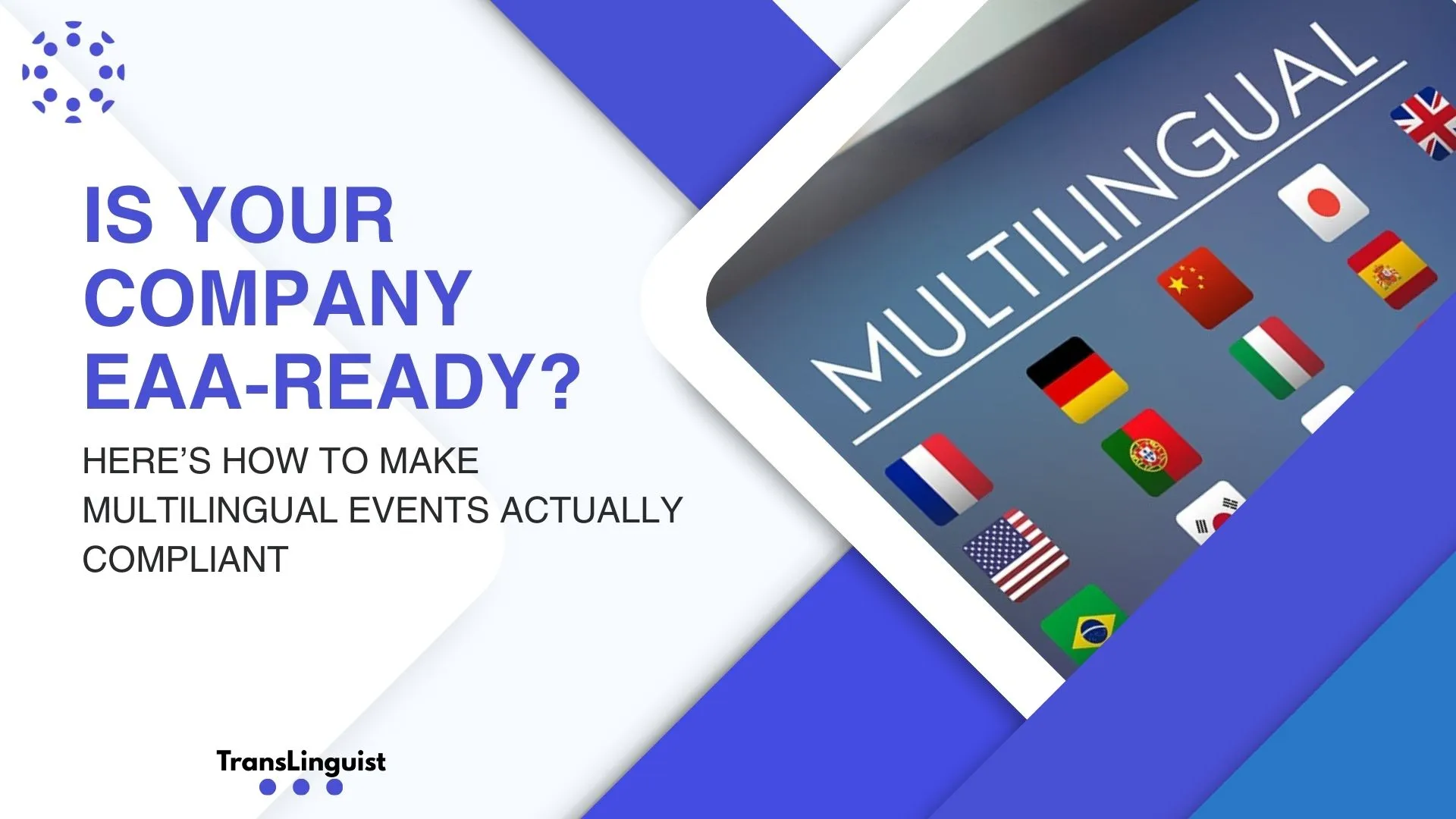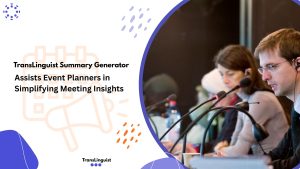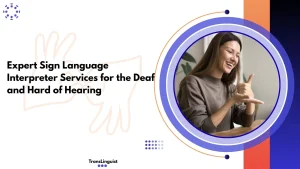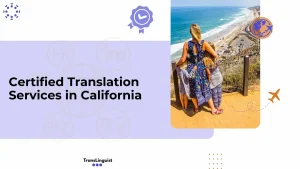Here’s the thing: this new rule, the European Accessibility Act (EAA)? It’s not just another legal checkbox. It’s a full-on shift in how we do events. Especially multilingual ones.
If you’re hosting webinars, hybrid conferences, or even a fancy launch party with global guests, you’re going to need to rethink a few things. Like… “Can people with hearing loss follow along?” or “Can blind attendees even access your platform?”
Anyway, in this blog (chat?), I’ll walk you through:
- What this EAA thing is—and why it’s a big deal
- The stuff people usually mess up
- Real examples from the language industry (because yes, people are already doing this right)\
- A simple checklist so you know where you stand
- And how we at TransLinguist are quietly helping people crush it
Let’s do this.
So, what is the EAA?
Alright. The European Accessibility Act is basically the EU saying, “Hey, if you’re providing digital services here, everyone needs to be able to use them.”
That includes apps, websites, e-books, ATMs, and—yep—events. Live, virtual, hybrid, all of it.
Starting June 28, 2025, you’ll need to make sure your events are accessible to people with disabilities. That means:
- Live captions
- Sign language options
- Screen-reader-friendly platforms
- Multilingual support
And before you ask—yes, this applies to you even if your company is based outside Europe, as long as you’re hosting events for an EU audience.
Wait… what happens if we don’t do this?
Short version: It’s not pretty.
You could face legal penalties. Fines. Event disruptions. Attendees walking out or—worse—dragging your brand on social media.
But even without the legal stuff… do you really want to exclude people from your event because of something fixable?
Exactly.
Real Talk: What It Looks Like in the Language World
Now, in the language industry, we’re kind of at the frontlines of this accessibility shift.
Here’s what’s happening:
Event platforms are scrambling to keep up. Zoom and Teams are starting to add captioning and multi-language audio, but it’s not always smooth sailing. Like that time one client’s captions stopped working mid-keynote… not ideal.
Clients are asking better questions. Instead of “Can we get a translator?” it’s now, “Can we have Spanish and French audio channels plus captions and a sign language interpreter?”
At TransLinguist, we’ve had companies come to us in a panic. One was hosting a six-language medical webinar with 4,000 attendees. We helped them go from zero access to full EAA-ready setup in under two weeks.
Point is—it’s happening now. This isn’t “someday.” It’s today.
The Usual Mistakes (and How to Not Make Them)
Let’s run through the usual accessibility fails. These are the things companies mess up most—maybe not on purpose, but still.
❌ Leaving it all till the last minute
You can’t just throw in a captioner two hours before the event and call it compliant.
Fix: Plan for accessibility from the get-go.
❌Relying only on auto-captions
They miss context. They mangle names. Sometimes they’re just… bad.
Fix: Use professional, real-time captioners. (Yes, they exist. Yes, they’re worth it.)
❌Not supporting screen readers or keyboard navigation
Especially in hybrid events, your landing page might look great—but try using it without a mouse.
Fix: Test your stuff with accessibility tools. Better yet, get feedback from actual users with disabilities.
❌Forgetting post-event materials
The recording is great, but without captions or a transcript? Kind of useless for a lot of folks.
Fix: Offer multilingual subtitles, transcripts, and downloads in accessible formats.
Quick Self-Check: Are You EAA-Ready?
Here’s a gut-check list. Be honest with yourself:
- Can your event platform handle multiple language channels?
- Do you provide live captions—and not just in English?
- Is there a sign language interpreter option?
- Can blind attendees navigate the interface with screen readers?
- Are your post-event recordings captioned and transcribed?
- Do you have a clear accessibility statement on your event page?
If you’re missing even one… yeah, you’ve got work to do.
So, How Do You Actually Make Your Events Compliant?
Let’s keep this practical.
Bake accessibility into your plan
Like, before you book the speaker or design the invite. Start with, “How can everyone take part in this?”
Bring in certified language pros
Not just someone who “speaks the language.” You need interpreters who understand both the technical side and the cultural nuance.
Use platforms that play nice with accessibility
Ask: Can it do simultaneous interpretation? Are captions easy to toggle? Can attendees adjust fonts or navigate without a mouse?
Offer content in every format
Live? Yes. But also post-event videos with multilingual captions. And downloadable PDFs. And screen-reader-friendly decks. Cover all your bases.
Why TransLinguist Makes This Easy
We’ve been in this space for a while now, and honestly? We’ve seen it all.
We work with companies that run 3-person Zoom trainings and others that host 10,000-person conferences on four continents. Whatever the size, we help them:
- Set up video remote interpretation (VRI) in 50+ languages
- Provide certified interpreters with EAA knowledge
- Deliver real-time captions and post-event subtitles
- Support sign language (multiple types!)
- Localize entire events—content, visuals, everything
Real example?
One global NGO had 2 days to turn a hybrid summit into a multilingual, accessible experience. 6 languages. 2 sign language interpreters. 1 platform overhaul. We pulled it off—and their feedback?
“That was the first time our entire audience could fully engage.”
Boom.
Final Thoughts
Let me say this: making your events accessible isn’t just about avoiding fines or impressing a regulator. It’s about showing up for your audience. People remember when you go the extra mile to include them. They also remember when you don’t. So don’t wait for the last minute. Don’t cross your fingers and hope auto-captions will save the day. Start now. Make accessibility your superpower, not your burden. And if you’re wondering where to start? You already know.
Let’s talk. [Book a consultation with TransLinguist] — we’ll help you sort it all out.
FAQs
What is the European Accessibility Act (EAA) in one sentence?
An EU-wide law making inaccessible many digital products and services—including live, virtual, and hybrid events.
When do the event requirements come into force?
From 28 June 2025 (with enforcement through national laws of the EU Member States).
Does the EAA apply to companies outside the EU?
Yes—if you are selling to or holding an event for audiences in the EU.
Types of events that are to be covered?
Webinars, live streams, hybrid conferences, virtual expos, product launches, training sessions, platform, registration page, and post-event materials.
Typical accessibility features for events?
Real-time captioning with sign language interpretation available; screen-reader-friendly platform and documents with keyboard navigation; separate audio channels per language and accessible post-event recording/transcripts for two languages



